Wnt5a-induced cell migration is associated with the aggressiveness of estrogen receptor-positive breast cancer
- PMID: 29765514
- PMCID: PMC5940389
- DOI: 10.18632/oncotarget.24761
Wnt5a-induced cell migration is associated with the aggressiveness of estrogen receptor-positive breast cancer
Abstract
Elevated expression of Wnt5a is associated with malignancy, cell invasion, and metastasis. The role of Wnt5a expression in breast cancer remains elusive. We investigated the significance of Wnt5a expression in breast cancer. The relationship between Wnt5a expression and clinicopathologic factors was assessed in invasive breast cancer (n = 178) resected at Hiroshima University Hospital between January 2011 and February 2014. Wnt5a was expressed in 69 of 178 cases (39%) of invasive breast cancer and correlated strongly with estrogen receptor (ER) expression (P < 0.001). Wnt5a expression in ER-positive breast cancer correlated significantly with lymph node metastasis, nuclear grade, and lymphatic invasion. The recurrence-free survival was shorter in breast cancer patients with Wnt5a expression than in those without (P = 0.024). The migratory capacity of ER-positive breast cancer cells increased with constitutive expression of Wnt5a and decreased with Wnt5a knockdown. DNA microarray analysis identified activated leukocyte cell adhesion molecule (ALCAM) as the primary gene induced by Wnt5a. ALCAM was expressed in 69% of Wnt5a-positive but only 27% of Wnt5a-negative cancers (κ = 0.444; P < 0.001). The inhibition of ALCAM reversed the enhanced migratory effect of Wnt5a, confirming the importance of this protein in the migration of ER-positive breast cancer cells. Wnt5a expression is related to high malignancy and a poor prognosis in ER-positive breast cancer. We suspect that Wnt5a expression increases the malignancy of breast cancer by increasing the migratory capacity of cancer cells through the induction of ALCAM expression.
Keywords: ER-positive breast cancer; Wnt5a; activated leukocyte cell adhesion molecule; cell migration; prognosis.
Conflict of interest statement
CONFLICTS OF INTEREST No potential conflicts of interest were disclosed.
Figures
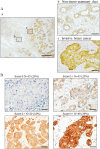
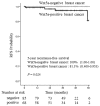
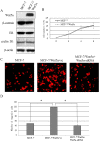
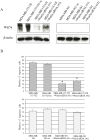

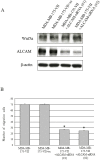
Similar articles
-
Activated Leukocyte Cell Adhesion Molecule (ALCAM) is associated with suppression of breast cancer cells invasion.Med Sci Monit. 2006 Jul;12(7):BR245-56. Epub 2006 Jun 28. Med Sci Monit. 2006. PMID: 16810131
-
Expression of the cell to cell adhesion molecule, ALCAM, in breast cancer patients and the potential link with skeletal metastasis.Oncol Rep. 2008 Feb;19(2):555-61. Oncol Rep. 2008. PMID: 18202807
-
Clinical implications of activated leukocyte cell adhesion molecule expression in breast cancer.Mol Biol Rep. 2012 Jan;39(1):661-8. doi: 10.1007/s11033-011-0783-5. Epub 2011 Jun 14. Mol Biol Rep. 2012. PMID: 21670959
-
Biologic role of activated leukocyte cell adhesion molecule overexpression in breast cancer cell lines and clinical tumor tissue.Breast Cancer Res Treat. 2011 Sep;129(2):347-60. doi: 10.1007/s10549-010-1219-y. Epub 2010 Oct 23. Breast Cancer Res Treat. 2011. PMID: 20972617
-
[Estrogens, cathepsin D and metastasis in cancers of the breast and ovary: invasion or proliferation?].C R Seances Soc Biol Fil. 1998;192(2):241-51. C R Seances Soc Biol Fil. 1998. PMID: 9841098 Review. French.
Cited by
-
Clinical Importance of Wnt5a in the Pathogenesis of Colorectal Cancer.J Oncol. 2021 Sep 23;2021:3136508. doi: 10.1155/2021/3136508. eCollection 2021. J Oncol. 2021. PMID: 34603445 Free PMC article. Review.
-
The Wnt Signalling Pathway: A Tailored Target in Cancer.Int J Mol Sci. 2020 Oct 18;21(20):7697. doi: 10.3390/ijms21207697. Int J Mol Sci. 2020. PMID: 33080952 Free PMC article. Review.
-
ALLSTAR: Inference of ReliAble CausaL RuLes between Somatic MuTAtions and CanceR Phenotypes.Bioinformatics. 2024 Jul 22;40(7):btae449. doi: 10.1093/bioinformatics/btae449. Online ahead of print. Bioinformatics. 2024. PMID: 39037955 Free PMC article.
-
An Autocrine Wnt5a Loop Promotes NF-κB Pathway Activation and Cytokine/Chemokine Secretion in Melanoma.Cells. 2019 Sep 10;8(9):1060. doi: 10.3390/cells8091060. Cells. 2019. PMID: 31510045 Free PMC article.
-
Stem Cell Marker Expression in Early Stage Colorectal Cancer is Associated with Recurrent Intestinal Neoplasia.World J Surg. 2020 Oct;44(10):3501-3509. doi: 10.1007/s00268-020-05586-z. World J Surg. 2020. PMID: 32647988 Free PMC article.
References
-
- Nusse R. Wnt signaling in disease and in development. Cell Res. 2005;15:28–32. - PubMed
-
- Kikuchi A, Yamamoto H, Sato A. Selective activation mechanisms of Wnt signaling pathways. Trends Cell Biol. 2009;19:119–29. - PubMed
-
- Polakis P. The many ways of Wnt in cancer. Curr Opin Genet Dev. 2007;17:45–51. - PubMed
-
- Kikuchi A, Yamamoto H, Sato A, Matsumoto S. Wnt5a: its signalling, functions and implication in diseases. Acta Physiol. 2012;204:17–33. - PubMed
-
- Bittner M, Meltzer P, Chen Y, Jiang Y, Seftor E, Hendrix M, Radmacher M, Simon R, Yakhini Z, Ben-Dor A, Sampas N, Dougherty E, Wang E, et al. Molecular classification of cutaneous malignant melanoma by gene expression profiling. Nature. 2000;406:536–40. - PubMed
LinkOut - more resources
Full Text Sources
Other Literature Sources
Research Materials
Miscellaneous

